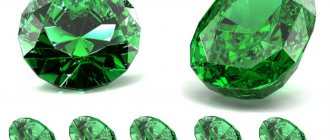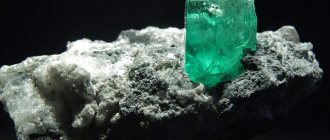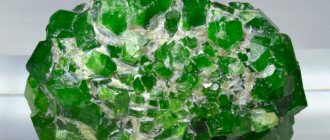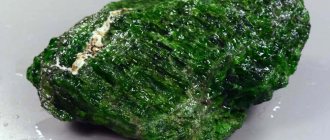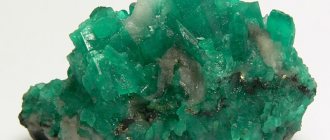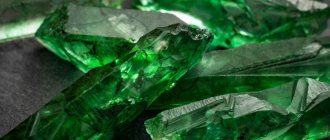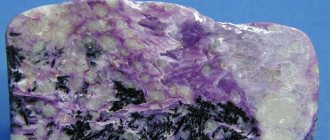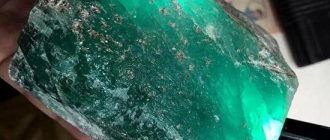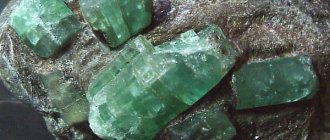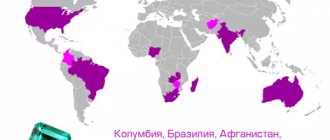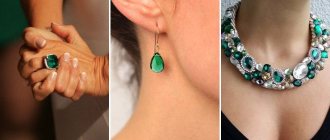- Demantoid (garnet group).
- Color: emerald green to golden green.
- Hardness: 6.5–7 points.
- Density: 3.83–3.85 g/cm³.
The word “demantoid” can be translated as “diamond-like” (German demon - “diamond”, Greek eidos - “similar”). Demantoid is a rare variety of transparent bright green andradite garnets. Their color is caused by impurities of iron and chromium, while the yellow tints are caused by titanium compounds.
The very name of the stone indicates its outstanding property - an incomparable play of light. Some gem traders claim that demantoid is capable of “burning” even in the shadows.
It is the most expensive variety of garnet and one of the most spectacular stones. Due to its incredible performance and great rarity, the demantoid is highly valued on the jewelry market. There is an explanation for his game: the stone has a very high light refraction - 1.888. The dispersion of the stone is also of great importance - the ability to reflect light passing through its faces and decompose it into all the colors of the rainbow.
Its color spectrum includes many shades of green, ranging from faint yellowish-green to golden brown-green. Particularly prized is the deep emerald green color, which is very rare. Demantoid crystals are usually small, but very beautiful. Large specimens are extremely rare. Only a few demantoids weigh more than 2 carats when cut, while most rarely reach 1 carat. So, small stones predominate in jewelry.
Deposits and mining After demantoid was first discovered in the Ural Mountains, it quickly became one of the most coveted stones. Jewelers in Paris, New York and St. Petersburg quickly found a use for it. Carl Faberge loved it very much for its amazing playing and often used it in his masterpieces. However, after World War I, the green star of garnets began to fade. It very rarely appeared in trade, and these were mainly old jewelry or remnants of stocks from the Ural deposits.
Single demantoids were found in other places. For example, in the Congo and in 1975 in Korea, but they were not suitable for jewelry purposes. This situation suddenly changed in the mid-1990s when a new field was discovered in Namibia.
Story
The name of the stone means “diamond-like” (from the German Diamant - diamond and the ancient Greek εἶδος - appearance, appearance). It was invented by Nils Gustav Nordenskiöld, a Finnish ore explorer who worked in Russia.
The history of the mineral begins in Russia:
- The first deposits on the planet were discovered in 1874 by Vasily Kalugin on the Bobrovka River (Middle Urals). Later, placers were found in the vicinity of the neighboring village of Poldnevoye.
- The largest annual production of jewelry grade demantoid (104 kg) occurred in 1913. Mostly these were crystals up to half a centimeter.
- Local toponymy determined other names for the demantoid: Ural emerald/olivine, Bobrovsky garnet, Ural/Russian/Siberian/trade chrysolite. Europeans called the stone Russian or Siberian chrysolite.
The record holders among Ural demantoid stones are 252 and 149 carats.
- In 1887, the stones became exhibits at the Siberian-Ural Exhibition, after which they became favorites of high society in both Russian capitals.
Two years later, they gained worldwide fame: the demantoid was provided with the World Exhibition in Paris.
History of demantoid
The Demantoid stone was discovered in the Urals in 1868 in gold mines. There has never been a mineral like this found in the world. Because of its beautiful green appearance and shine, the stone was called demantoid, which means “diamond-like.” The Ural demantoid very quickly won the love of the Russian nobility. He was also very loved and appreciated by Carl Faberge.
At an exhibition in France in 1889, the demantoid stone gained worldwide fame and soon it would become the best-selling gemstone from Russia. Large collectors and famous jewelry houses will begin to purchase it. In 1913 there was a peak in the production of this mineral. The production amounted to a record 104 kilograms.
It is worth noting that in Europe the new green stone was often called “Siberian chrysolite” or sometimes also “Russian chrysolite”
Extraction of demantoid in the Urals - photo
Description
Demantoid is a representative of the garnet group, a variety of andradite. It is less common than other garnets.
The stone is transparent, with green or green with yellowish tints. All crystals are classified as jewelry.
Faceted demantoid
A feature of the Ural demantoid, due to which it is placed above other stones, is the inclusion of byssolite. This ponytail enhances the originality of the mineral. But not every demantoid is present.
Physico-chemical characteristics
From a chemist's point of view, demantoid is a silicate with an admixture of iron, chromium and titanium. The last component gives the stone a yellowish tint.
| Formula | Ca3Fe2(SiO4)3 |
| Impurity | chromium |
| Color | green |
| Shine | glass, diamond |
| Transparency | transparent |
| Hardness | 6,5-7 |
| Density | 3.84 g/cm³ |
In terms of light dispersion, it is the first among garnets and ahead of diamond.
Place of Birth
Today, stone deposits amount to only a few. Industrial-scale mining is carried out only in Russia, in the Middle Urals. Local material is of the highest quality in the world. The deposits of Kamchatka are being studied for development.
The world's main suppliers of jewelry grade raw materials are Iran and Madagascar.
The gem is also found in Africa - Kenya, Tanzania, Namibia.
Where is the stone used?
The main area of use of demantoids is jewelry making:
- A pebble shines more than a diamond, so it is cut in the same way (that is, diamond-cut) or in steps.
- More often it becomes inserts of rings, earrings, brooches. The frame is white metals: platinum, gold, silver. This is luxury jewelry.
- Pieces with a “cat’s eye” effect or with golden “sparkles” are valued even more.
You can wear jewelry with demantoid stones at any age: the younger the owner, the lighter the stone is chosen.
Substandard jewelry and interesting examples of stones in the rock are taken by collectors.
Ring with demantoid
LiveInternetLiveInternet
Saturday, September 18, 2022 06:51 + to quote book
At the beginning of the 20th century, an extraordinary story happened in Nizhny Novgorod involving jewelry with demantoid. Ariadna Artyukhina, the daughter of a local merchant, married the son of a bankrupt landowner Alyabyev. Artyukhin was dissatisfied with the alliance with the impoverished family, but this was the only way he could get into high society. The bride had a rich dowry, which included a box full of jewelry. In one of the decorations, the groom recognized his mother's set - a necklace and bracelet, into which multi-colored garnets were inserted. Once because of this headset, robbers killed his mother.
There was a huge scandal that almost ended in a duel. But this did not stop the wedding, and the young people got married. Perhaps this would have been the end of the matter. But the young wife gave birth to a black child. This came as a surprise even to the mother herself, because she claimed that she did not know any other man except her husband, and had never seen blacks. People believed that this was all retribution for the sins of their ancestors and the family was cursed. Soon Ariadne and her baby were found strangled, and her husband disappeared. Jewelry was also missing. After the funeral, it turned out that the set was buried at the grave.
They began to say that miracles were happening at Ariadne’s resting place - multi-colored lights appeared, similar to the reflections of gems. A belief arose that if a barren woman goes to her grave at night, God will soon send her a child. One of the bourgeois women decided to do this. She returned from the cemetery completely gray and was silent for a long time. Then she said that at midnight a woman came out of the grave with a child in her arms. The deceased walked for a long time in the cemetery between the graves and cried, but at dawn she returned to the coffin. Soon the bourgeois woman became pregnant.
Demantoid is the pride of the Urals. The stone is often mentioned in Bazhov's works. True, there was confusion with the name. In those days it was often called chrysolite or goldstone. Bazhov writes that this is a cheerful pebble that gives off the scent of spring.
The first demantoids were found in the Urals in the middle of the 19th century, but Academician Fersman found out that these gems were known to our ancestors long before that. This is proven by excavations in Iran. Archaeologists here found gold and platinum jewelry with demantoid inserts. Fersman suggests that the stone, called in ancient times “Scythian emerald”, is a Ural demantoid. Perhaps it reached other countries through the Scythian country, which is why it got its name. Over time, for unknown reasons, the stone was forgotten until father and son Kaluzhny discovered it again.
True, Kaluzhnye was not the first to find the mineral. In the 50s of the 19th century, precious metals were washed near the village of Elizavetinskoye near Nizhny Tagil, and green gems were found with them. One day the stones fell into the hands of Professor Nordenskiöld, who was conducting experiments to improve copper smelting. He could not determine the composition of the mineral and transferred it to the Mining Institute of St. Petersburg. So it gathered dust there until the museum curator Nefediev decided to conduct experiments. He mistakenly classified the stone as a type of olivine. 30 years later, mining engineer Eremeev correctly classified the mineral, calling it garnet.
The second deposit was discovered in 1874 by Alexander Vasilyevich Kalugin. Traveling through the Urals, he found several yellow-green pebbles on the banks of the Poskakukha River. Kalugin did not know that the stone had already been found, described and classified. He called it chrysolite and it caught on surprisingly quickly. Even in the works of scientists describing the stone, the erroneous names chrysolite and olivine flashed.
Fame came to the stone after the industrial exhibition of 1887 in Yekaterinburg, where the works of Ural craftsmen were presented. Foreigners became interested in demantoid products. The Nizhny Tagil and Lunievsky plants began mining the mineral. About 100 kilograms of stone were mined per year. Demantoid, together with emerald, became the most important Russian stones at the beginning of the 20th century. Following the Yekaterinburg exhibition, the demantoid was successfully exhibited in Paris, Montreal, and Tokyo. Prices for it have risen almost five hundred times.
Demantoid is a green garnet, a variety of andradite of jewelry quality. The name of the mineral translates as “diamond-like.” It has a distinctive feature - a bright shine that intensifies under artificial lighting. A ray of light entering a crystal is refracted and decomposed into all the colors of the spectrum, forming rainbow sheaves.
The green color of the mineral is formed by impurities of iron and chromium. The more chromium in the composition, the brighter and more saturated the green tint. If titanium is present in the mineral, yellow tints appear.
Ural demantoids have characteristic inclusions of bissolite fibers or hollow channels left from its destruction. People called them “pony tail”. Sometimes clusters of fibers form a cat's eye effect. This is an example of the fact that sometimes foreign inclusions do not spoil the stone, but decorate it, raising the price. “Ponytail” is an indicator of the authenticity of the mineral. It is noteworthy that minerals found in other countries do not contain such inclusions.
Demantoid rarely forms independent crystals. Often these are small ingrowths into the rock. Demantoid grains do not often reach a size larger than 5 mm. Most processed minerals weigh no more than 2 carats. Crystals larger than 10 mm are considered rare and cost more than $1,000 per carat. Small crystals weighing up to two carats are cheaper, about $100 per carat. Demantoid is a precious stone used as an insert in expensive jewelry. It is less common than diamond, but in popularity and price it does not exceed it. It is purchased by lovers of unusual jewelry that is not available on the mass market.
The maximum extraction of stone was carried out in Russia in 1913. But gradually production decreased and stopped completely. Now the Ural deposits are considered selected. Gradually, the mineral began to be found in other places: Kamchatka, Chukotka. Deposits were discovered in the Congo and Korea, but the local stone is not suitable for jewelry purposes. The situation changed in the 90s after the discovery of a deposit in Namibia. Many millions of years ago, in these places, magma began to rise from the depths of the earth, bringing its riches upward, but no eruption occurred, and the lava froze. The wind destroyed the soil for a long time until it reached the formations where demantoid crystals were hidden in granite rocks. The local stone has a light green and blue-green color. African green pomegranate is valued less than Russian one. It lacks the inclusions of byssolite to be ideal.
Demantoid was discovered recently, so its medicinal and magical properties have been little studied. However, it has long been noted that its main purpose is to take care of the continuation of the human race. It treats all types of sexual dysfunctions. A ring on the middle finger of the right hand treats impotence in men, and a bracelet on the left hand relieves a woman from infertility. The mineral also increases libido. Pendants and necklaces with stones treat diseases of the upper respiratory tract, improve immunity, stabilize blood pressure and treat cardiovascular diseases.
Like any other green stone, demantoid calms, relieves depression, stress, and anxiety.
| Categories: | Precious stones Minerals Stone cutting Jewelry |
Cited 13 times Liked by: 21 users
Like share
0
Like
- 21
I liked the post - Quoted
- 0
Saved
- Add to quote book
- 0
Save to links
Liked21
0
How to identify a fake
Demantoid is prestigious, rare and expensive. No wonder it's being counterfeited. More often, ordinary quartz or glass serve as “understudies”.
The properties of natural stone help determine the origin:
- Demantoid is endowed with a high refractive index, so it is processed and shines like a diamond. It's best to check the shine during the day, but even in artificial light it's impressive: the edges cast delightful reflections.
- In Ural stones, under a magnifying glass one can almost always discern a “pony’s tail”.
- Unlike glass, natural stone does not heat up immediately in your hands.
- Demantoids larger than a centimeter in diameter are not available for sale.
Natural demantoids are supplied with a certificate of conformity or other document confirming their natural origin and quality.
How to distinguish natural demantoid from a fake
To determine whether this is a natural demantoid or a fake, you need to know the characteristics of a real stone. Properties of demantoid:
- dispersion is one and a half times higher than that of diamonds: the play of the stone is noticeable even in dim lighting;
- bright diamond shine;
- golden inclusions of asbestos-like bissolite crystals (“horsetail”).
In addition, demantoid, like other garnets, is pyroelectric - it attracts fluff or finely chopped paper if rubbed against a cloth. Plus, the mineral has high hardness and cannot be scratched by glass.
In nature, demantoid crystals are found in small sizes - no more than 5 mm, as a rule. Therefore, if you see a piece of jewelry with a large insert, this is already a reason to doubt the authenticity of the stone. Moreover, even a ring with a small insert will not be inexpensive.
How to care for stone
An expensive, beautiful stone or jewelry with it deserves proper care:
- For storage, a separate, upholstered box or durable box is provided.
- Clean jewelry with a soapy solution in warm water, without aggressive household chemicals. Dry with a soft cloth.
- Demantoid is great in the sun, but you shouldn’t overuse it.
Prolonged exposure to direct sun will cause the mineral to fade.
- You cannot wear jewelry in the pool, sauna, or on the beach.
Jewelry is worn after applying makeup and fragrances.
Demantoid stone in jewelry
Green garnet is one of the rarest stones in the world. And in addition, not all mined minerals are of good quality. The demantoid stones of the Urals are considered the best. These minerals are still mined there today. And they are still valued as before and are considered one of the best in the world.
It should be noted that the Ural demontoid very often has some peculiarity from other stones mined on our planet. In particular, it has some specks inside the structure of the stone that resemble a tuft of hair. This effect in the stone is called “ponytail”.
It should be noted that similar structures are found in other minerals. Only in other minerals does a similar effect greatly affect the cost of the stone. However, not for the better, that is, the price becomes lower. Surprisingly, with demantoid stone the situation is completely opposite. A stone with a ponytail structure is valued higher and costs more accordingly.
Easter egg “Spring flowers” with demantoid stones. (Carl Faberge, 1899)
More people want to buy jewelry containing Ural demantoid than, for example, if the same jewelry contained a mineral mined from another place. Therefore, the price of products with Ural stone is in most cases always more expensive. The Faberge factory loved to add green stone to its jewelry.
Approximate prices for jewelry: buy a ring with demantoid, which is shown in the photo for about 15,000-20,000 rubles.
buy earrings with demantoid, as shown in the photo, for about 25,000-35,000 rubles.
buy a pendant with a demantoid, which is shown in the photo for about 15,000-25,000 rubles.
The price of jewelry, of course, largely depends on the size, purity and properties of the stone in the jewelry.
Price
According to the jewelry classification, demantoid is considered a semi-precious stone, so the price of jewelry is relatively affordable (RUB):
- earrings (925° silver, 2 stones – 0.56 carats) – 3,600;
- cut, round (4.5x4.5 mm; 0.35 carats) – 2,160;
- untreated agglomerate (14x12x10 mm) – 500;
- demantoid on quartz (90x72x37 mm) – 9,600.
Demantoid 0.81 carats
A set of three faceted round stones with a total weight of 8 carats with dimensions 8x5x5 mm is offered to buy on the Internet for almost 250,000 rubles.
Magic properties
Esotericists determined the magical properties of the gem half a century after the discovery, by the beginning of the 20th century.
The following capabilities of the mineral were revealed:
- The main mission of the stone is love relationships. Decoration will help you find your soul mate, creating a strong family.
- The mineral will protect the family hearth from the evil eye, the elements, and internal turmoil. The same applies outside the home.
- This is an attribute of careerists and ambitious people. The owner of the talisman will become a responsible, punctual, hardworking person. Every minute will be used for business. Having set a goal, he will begin to go straight towards it - without being distracted or despairing in case of failures.
Demantoid helps a person find himself and his life’s work by activating dormant talents. Teaches you to value money and time.
- This is an ally in solving problems that are vital for the owner. It is enough to mentally clearly formulate the essence of the question and ask the pebble for help. The right decision will not take long to arrive.
- The stone will gently “force” the owner to develop intelligence and grow spiritually. He will not allow you to stoop to meanness or petty squabbles. But those around him will subconsciously respect him.
- This is a salvation for shopaholics: with such a talisman, impulsive purchases will be excluded. Instead, the owner of the stone will feel a taste for accumulating money and will be interested in investing. It is not for nothing that demantoid is considered the stone of businessmen: it helps to see through a business partner, detect dishonesty, conclude profitable deals, and protects against ruin.
- This is a good gift for restless introverts. The pebble will bring calmness, tranquility, agreement with oneself and the world. Will not allow you to deviate in a dubious direction.
Light stones help you move forward; dark stones are needed if stability is valued and you want to consolidate your successes.
The stone does not help in dirty deeds and rituals.
Demantoid stone – Magical properties
Can stones regulate our capabilities and attitude towards life? If they could, many of us would live correctly and be happy. Probably, those whom astrologers recommend wearing demantoid, and these are people born under the signs of Air (Libra, Aquarius, Gemini), would definitely buy this beautiful stone, despite its high price. After all, the stone brings happiness, helps you to be more collected and concentrate your attention on a specific activity, as they say, “not to get scattered,” but “to focus.”
Demantoid promotes the proper organization of his working time and available funds. These are the properties that are familiar to successful people who achieve heights in their business. For women, the precious crystal gives attractiveness and brings happy love, and for men - to make decisions in a planned enterprise, leading to success.
Therapeutic effect
The healing properties of demantoid extend to the emotional and physical state of the owner:
- Green color is beneficial for vision in case of farsightedness and myopia: it is enough to contemplate the pebble for a few minutes a day.
- The mineral normalizes the nervous system: neutralizes depression, increases stress resistance and quality of sleep.
- Heals, cleanses blood vessels, normalizes blood pressure. Beads, pendant or brooch help the heart work better.
- A pendant with demantoid will solve respiratory problems: bronchitis, bronchial asthma, pneumonia, tuberculosis.
- A stone in contact with the skin cleanses and heals it.
Demantoid helps solve intimate problems:
- A silver bracelet is needed for ladies trying to overcome infertility.
- A gold ring on the right middle finger will help with impotence or protect men from the risk of its occurrence.
- If marital passion has cooled down, a mineral in identical jewelry will rekindle it.
Earrings with demantoid
In all cases, a raw crystal is also suitable.
Demantoid and Zodiac
Astrologers have found that the demantoid is the ideal talisman for Aquarius and Gemini. He showers them with gifts: attracts luck, helps them make a career, find love.
Suitable for other zodiac signs:
- This is the best option for ambitious Leo or Sagittarius: they will fly up the career ladder and reach business Olympus.
- Libra will learn to bring things to the end, any project will be successful. Families will begin to enjoy quiet domestic happiness without betrayal or scandals; those who are single will find their soul mate.
Demantoid is not suitable for Pisces : life will turn into a series of unpredictable events, problems, troubles.
For other zodiac signs, this is simply a prestigious decoration.
Demantoid in astrology and the magical properties of the stone
It is believed that green garnets (demantoid, uvarovite, tsavorite) attract money, increase the owner’s well-being, and bring good luck.
Demantoid is the teachers' mascot. Keeps the owner from rash actions, makes thoughts sublime. According to astrologers, the so-called Ural emeralds will be especially useful for representatives of the air element - Libra, Aquarius and Gemini. Among the zodiac signs for whom the demantoid is not particularly suitable is called Pisces. They are advised to pay attention to other green stones.
